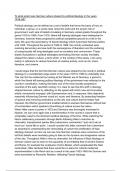To what extent was German culture shaped by political ideology in the years
1918–89?
Political ideology can be defined as a set of beliefs that forms the basis of how an
individual, a group, or a social class views the world and the proper role of
government; such sets of beliefs circulating in Germany varied greatly throughout the
period 1918 to 1989. From 1918, liberal left leaning ideologies were widespread in
Germany, however these progressive political sympathies ground to a halt in the
early 30s upon the ascendency of fascist ideology which tyrannised German politics
until 1945. Throughout the period of 1949 to 1989, the country embarked upon
restoring democracy and saw both the reemergence of liberalism and the surfacing
of unequivocally left wing ideologies such as socialism and communism. These
drastic fluctuations in political ideologies dominating German society inevitably
shaped the nation’s culture, a term which, in the context of this essay, I am using
mainly in reference to various branches of creative activity, such as art, music,
literature, and cinema.
I would argue that the fact that German culture was shaped by the country’s political
ideology to a considerably large extent in the years 1918 to 1989 is undeniably true.
This can first be evidenced by looking at the Weimar era of Germany, a period in
which the liberal left leaning political ideology of the government was reflected in the
country’s constitution, making Germany one of the most socially progressive
countries of the early twentieth century. It is clear to see that this shift in ideology
shaped German culture by reflecting on the speed with which new and innovative
artistic movements emerged, with Expressionism and, in response, New objectivity
massively influencing German visual art, music and literature. By protecting freedom
of speech and removing restrictions on the arts and culture that the Kaiser had
imposed, the Weimar government enabled artists to express themselves without fear
of recrimination which sparked a flourishing of culture across the nation.
When Hitler came to power in 1933 and Germany was thoroughly immersed in
Nazism, we can once again see a transformation in the country’s culture that is
undeniably owed to the dominant political ideology of the time. While watching the
Nazi’s celebratory procession through Berlin following Hitler’s induction as
chancellor, impressionist painter Max Liebermann commented ‘I just can’t eat as
much as I would like to puke’. I would consider this bitter comment from Libermann
as essential to understanding the remoulding of culture the proliferation of Nazi
ideology induced, as here we can see how German creatives were conscious of the
toll Nazi beliefs were inevitably going to take on the dynamic and imaginative nature
of the arts. Throughout Hitler’s time as chancellor, the influence of Nazi ideology on
German culture can be seen in the popularity of art imitating that of ancient Greece
and Rome, for example the sculptures of Arno Breker, which perpetuated the Nazi
racial ideal. Hitler declared that there would be no place for cultural modernist
experimentation in the Reich and as a result in the years 1933-1945 the German arts
were dominated by Romantic Realism, reflecting Fascist ideology.




